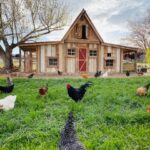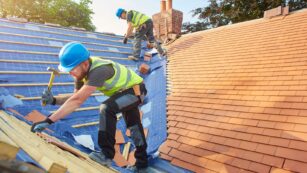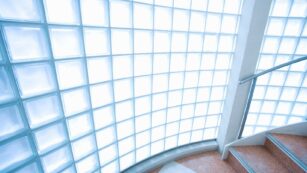Identification structure
Curved roofs are easy to recognize at first glance because they have distinctive curved elements. Traditionally, a curved roof is shaped like a dome or a hemisphere, but in more modern designs, architects have introduced curved elements on flat roofs or created unusual or asymmetrical curves to create a gentle wave shape. Some of the types of curved roofs you may be familiar with are
Barn roofs
Rounded barn roofs became popular in the 1920s. They were designed to maximize barn space so the farmer could store more hay in the attic. From the front, these barn roofs look like the top of an egg, with curved, puffy sides that come together at the top to form almost a point, but not quite. This roof style has stood the test of time so well that it is still often found on barns throughout North America, a significant portion of which is in the Midwestern United States.
Iconic roofs
Despite the functional benefits of curved roofs, architects have often designed buildings with curved roofs to make them stand out. Famous buildings with curved roofs that have become icons include the Sydney Opera House in Australia, the Taj Mahal in India and the U.S. Capitol Building in Washington, DC, USA.
History
Curved roofs are considered a fairly modern design style, as they look very different from the pitched roofs we are used to seeing. In recent years, curved roofs have been introduced into modern buildings to give the building an organic look and are therefore associated with modern architectural innovation.
However, curved roofs have been used for millions of years. There are examples of the original vault, the dome, in many historical periods, including ancient Persia, ancient China and Roman times. There is also evidence that domed buildings in Europe date back to the Middle Ages.
Bent roofers
Aesthetic appearance
Curved roofs have an aesthetic appeal that gives modern buildings an organic look and helps them integrate better with their surroundings. They are visually less bulky and less angular, so they adapt well to certain design styles.
Improvement of wind resistance
Curved roofs have less wind resistance and are more aerodynamic than conventional pitched roofs. This can be particularly useful in coastal areas with strong winds or in areas prone to storms and bad weather.
Less empty spaces
Curved roofs also offer great functionality, one of the main benefits being that they waste less space. Traditional pitched roofs have a lot of unused space at the top of the roof that can’t be used, but with a curved roof that’s not a problem.
The floors of the house can also be built higher, as the curved roof allows for better ceiling height without adding an empty top. Wasted space on pitched roofs can also increase energy costs, as the homeowner pays each year to heat the entire house, with much of the heat going into the attic and being wasted there. A curved roof leaves less room for heating, which can reduce heating costs.
Maximising natural light
Curved roofs come in a variety of shapes and sizes, and you can adjust the curvature to fit the location of your home to make the most of natural light. This allows you to create a brighter, airier building and reduce energy consumption.
Adherence to height restrictions
If you are building a home that must meet building code height restrictions, a curved roof can help you meet this requirement. Curved roofs can be much flatter than traditional pitched roofs. So if you have limited space in terms of height, choosing a curved roof may be the solution. A curved roof gives you more space to work from home. So you can have several floors in the same building subject to the height restriction.
Against curved roofs
Potentially higher costs
Buying a home with a curved roof will likely cost more than a traditional-style home because it is usually a unique design as opposed to a common design, and will therefore cost more.
However, if you are building a house, it is quite possible to choose a curved roof that costs in the same area as a standard roof, as the materials needed to build a curved roof can be cheap. The design of the curved roof you choose will have a big impact on the cost, but you should also consider the labor costs of the architect to design the roof and the contractor to build it.
A specialist technician may be required
Depending on the design of your curved roof, you may need to find professionals who have experience building this type of roof. Many construction companies can handle unusual building plans, but if you want to increase the chances that your roof will be installed without a hitch, it’s a good idea to hire a company that has built curved roofs before. The construction of a vaulted roof does not have to take longer than the construction of a standard roof, and in many cases can even be completed faster. Therefore, the labor cost of building a vaulted roof should be higher than that of a standard roof.
Types of curved roofs
If you are considering installing a curved roof for your building, there are many ways to incorporate arches into your roof design. Includes:
Roof with elbow pin
This type of roof has a silhouette very similar to that of a traditional gable roof, as it has two flat sides that meet to form a view from above. However, instead of forming a sharp corner, the two sides come together in an arc, giving the roof a rounded top. This type of curved roof gives the roof a softer appearance than a hard corner.
Painted roof with tubes
It is the most common of all types of curved roofs and is also called a convex roof. It has a constantly curving shape that gives the building the appearance of a symmetrical rounded roof.
Panels S
Roof panels can be S-shaped, with convex and concave curves. These panels are generally used in buildings where aesthetics are paramount, by designers who want to push the boundaries of traditional architecture. Although these types of curved roofs generally have limited functional use, they have a unique visual effect.
Elliptical plates and random curves
For a truly unique roof design, roof panels can be made in almost any shape and curved corners according to the architect’s idea. These types of curved panels can have smooth curves, extreme curves or multiple curves to create a ripple effect.
Cove roof
The bullnose roof has the shape of a traditional roof, but with a rounded lower edge. The curved part of the roof is like a false plate that seamlessly connects the roof to the side walls of the building. These types of roofs are usually chosen for their decorative effect and offer little more functionality than standard roofs. They really succeeded in making the building visually interesting.
Gothic arched roof
A Gothic arch is an arch consisting of two curved sides that meet at the top and form a point. This type of roof is often found on Gothic cathedrals and churches, but it is also a style that can be incorporated into modern curved roofs.
What is the resistance of curved roofs?
Curved roofs are just as strong and durable as traditional roofs. The durability of the roof depends on many factors, but first and foremost on the building material chosen. Many curved roofs are made of sheet steel, which is known for its durability and will stand the test of time.
Curved roofs can also be made of wood and wood shingles. Bent wood roofs are very durable, and if you choose wood shingles that are resistant to moisture and rot, such as. B. Teak, they remain in good condition for life. Shingles should also be treated to ensure their durability.
Post Views :
5
Related Tags:
types of curved roof,curved transition roof,disadvantages of curved roof,pyramid roof characteristics,curved roof price philippines,curved roof buildings,curved roof materials,curved roof structure,curved roof sheet,curved roof sketchup,different types of roofs with pictures,types of roof materials,dutch gable roof,types of roofs pdf,jerkinhead roof,cross gable roof,mansard roof vs gambrel roof,gambrel roof house,gambrel roof trusses,mansard roof definition,a curved roof utilizes what type of trusses,skillion roof,what are the different types of roof frame,mono-pitch roof advantages and disadvantages,types of roof materials philippines,types of roof shingles,types of roof sheets,Privacy settings,How Search works,curved roof construction details,best roofing material for curved roof,curved roof advantages and disadvantages,curved roof design,curved roof trusses













